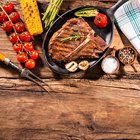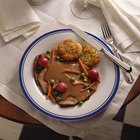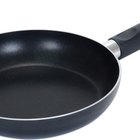
A high-quality roasting pan helps turn out excellent roast beef and other roasts. It's worth the expense to get a heavy pan with a rack and easily gripped handles. Anodized aluminum pans are sturdy and conduct heat well, making them a smart choice, while pans with an aluminum core and stainless steel coatings are good picks, too. Roasting pans sides should be no more than 2 inches high to allow for heat circulation and to prevent steaming food in its drippings. With a decent roasting pan and proper preparation, it's simple to make a beef roast that practically melts in your mouth.
Step 1
Remove the beef from the refrigerator about 90 minutues before roasting it so it doesn't go into the oven chilled. Cold meat doesn't cook evenly.
Step 2
Heat the oven to 475 degrees Fahrenheit if you want a well-browned exterior. Alternatively, heat it to 325 F if you're more concerned with minimizing meat shrinkage during roasting than nicely browning the outside. Give your oven about 30 minutes to heat up to the higher temperature or 20 minutes to reach the lower temperature.
Step 3
Blot moisture off the surface of the beef with paper towels. Pat on salt and pepper to taste, as well as any other spices or herbs you'd like to include. You could give your roast some heat with a favorite chili powder or Cajun seasoning, or add depth of flavor with some dried oregano, thyme or garlic powder.
Step 4
Press an oven-safe meat thermometer into the center of the beef roast. Don't let it touch bone if you have a bone-in cut, as this throws off readings. Because cooking times vary so much by cut and thickness of the beef, accuracy and consistency of your oven's temperature regulation, whether or not you start at a higher cooking temperature, roasting pan color and material and other considerations, the meat's internal temperature is the only sure way to know when it's cooked to the desired doneness.
Step 5
Cover the bottom of the roasting pan with aluminum foil to simplify cleanup if you don't intend to deglaze it to make a sauce for your beef roast. Leave it uncovered if you will deglaze. Put the rack in the roaster tray, put the beef on it and place it in the middle of the oven.
Step 6
Turn the heat down to 325 F after about 15 or 20 minutes if you began at a higher temperature to brown the beef. Otherwise, cook at a consistent 325 F for the entire roasting period.
Step 7
Remove the roast from the oven when it reaches 7 to 10 F below the desired internal temperature, as the temperature continues to rise during resting. The larger the roast, the more its temperature rises with residual cooking. While U.S. food safety standards call for cooking solid cuts of beef to 145 F, many cooks choose to go to only 120 F for rare meat, 130 F for medium-rare or 140 F for medium; others go further to 150 for medium-well or 160 for well done. Keep in mind that beef becomes drier and tougher the more it cooks.
Step 8
Leave the beef roast to rest for at least 10 to 15 minutes before carving it. If you don't, juices that seep out of the muscle fibers during roasting don't get reabsorbed and escape the meat when it's cut.
Related Articles

How Long Should Meat Rest After You ...

How to Cook a 15-Pound Rib Roast

Does Cooking at a Low Temperature for a ...

How to Cook Sliced Roast Beef for ...

How to Use an Electric Roaster to Slow ...

How to Cook Deer Sirloin
How to Cook a Spencer Roast

How to Cook a Beef Topside Roast

How to Cook Angus Beef in the Oven

How to Cook Beef Top Round Pot Roast
Cooking Guide for Semi-Boneless Beef ...

How to Cook a Beef Roast in a Roaster ...

How to Slow Cook a Rolled Rib of Beef

How to Cook Center Cut Chuck Steak

How to Cook Boneless Beef Chuck Medium ...

How to Cook Beef in a Toaster Oven

Calories in Beef Rump Roast
How to Slow Cook a Pot Roast With Beef ...

How to Cook a Large Amount of Corned ...

How to Convection Roast a Brisket
References
Tips
- Deglazing refers to scraping up the stuff cooked to the bottom of a pan after preparing food. It has concentrated flavor, making it valuable for sauces. After removing the beef and rack from the roaster, place the pan over medium-high heat on the stovetop. Pour in a splash of red wine, soy sauce, broth or other complementary liquid and vigorously scrape the bottom of the pan with a rubber-tipped or plastic spatula. Stir, add desired seasonings, reduce the liquid a bit, then pour it over the beef before serving.
Writer Bio
Eric Mohrman is a food and drink, travel, and lifestyle writer living in Orlando, Florida. He has professional experience to complement his love of cooking and eating, having worked for 10 years both front- and back-of-house in casual and fine dining restaurants. He has written print and web pieces on food and drink topics for Visit Florida, Orlando Style Magazine, CrushBrew Magazine, Agent Magazine, Dollar Stretcher Magazine, The 863 Magazine and other publications.
Photo Credits
Jupiterimages/Comstock/Getty Images